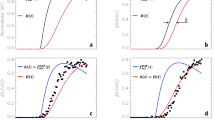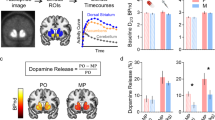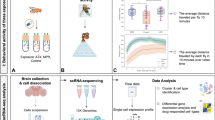Abstract
Previous studies have shown that the dopamine (DA) uptake blocker methylphenidate, a psychostimulant widely used for the treatment of attention-deficit hyperactivity disorder (ADHD), prevents the neurotoxic effects of the highly abused DA releaser methamphetamine. However, there is a lack of information about the pharmacological interactions of these two drugs at the behavioral level. When systemically administered within an interval of 2 h, previous administration of methylphenidate (10 mg/kg, intraperitoneal (i.p.)) did not modify locomotor activation induced by methamphetamine. On the other hand, previous administration of methamphetamine (1 mg/kg, i.p.) markedly potentiated methylphenidate-induced motor activation. With in vivo microdialysis experiments, methamphetamine and methylphenidate were found to increase DA extracellular levels in the nucleus accumbens (NAs). Methamphetamine, but not methylphenidate, significantly increased the extracellular levels of serotonin (5-HT) in the NAs. Methamphetamine-induced 5-HT release remained significantly elevated for more than 2 h after its administration, suggesting that the increased 5-HT could be responsible for the potentiation of methylphenidate-induced locomotor activation. In fact, previous administration of the 5-HT uptake blocker fluoxetine (10 mg/kg, i.p.) also potentiated the motor activation induced by methylphenidate. A selective 5-HT1B receptor antagonist (GR 55562; 1 mg/kg), but not a 5-HT2 receptor antagonist (ritanserin; 2 mg/kg, i.p.), counteracted the effects of methamphetamine and fluoxetine on the motor activation induced by methylphenidate. Furthermore, a 5-HT1B receptor agonist (CP 94253; 1–10 mg/kg, i.p.) strongly and dose-dependently potentiated methylphenidate-induced locomotor activation. The 5-HT1B receptor-mediated modulation of methylphenidate-induced locomotor activation in rat could have implications for the treatment of ADHD.
Similar content being viewed by others
Log in or create a free account to read this content
Gain free access to this article, as well as selected content from this journal and more on nature.com
or
References
Barr AM, Panenka WJ, MacEwan GW, Thornton AE, Lang DJ, Honer WG et al (2006). The need for speed: an update on methamphetamine addiction. J Psychiatry Neurosci 31: 301–313.
Baumann MH, Phillips JM, Ayestas MA, Ali SF, Rice KC, Rothman RB (2002). Preclinical evaluation of GBR12909 decanoate as a long-acting medication for methamphetamine dependence. Ann NY Acad Sci 965: 92–108.
Berridge CW, Devilbiss DM, Andrzejewski ME, Arnsten AF, Kelley AE, Schmeichel B et al (2006). Methylphenidate preferentially increases catecholamine neurotransmission within the prefrontal cortex at low doses that enhance cognitive function. Biol Psychiatry 60: 1111–1120.
Bishop C, Walker PD (2003). Combined intrastriatal dopamine D1 and serotonin 5-HT2 receptor stimulation reveals a mechanism for hyperlocomotion in 6-hydroxydopamine-lesioned rats. Neuroscience 121: 649–657.
Brown RT, Amler RW, Freeman WS, Perrin JM, Stein MT, Feldman HM et al (2005). Treatment of attention-deficit/hyperactivity disorder: overview of the evidence. Pediatrics 5: 749–757.
Bruinvels AT, Palacios JM, Hoyer D (1993). Autoradiographic characterisation and localisation of 5-HT1D compared to 5-HT1B binding sites in rat brain. Naunyn Schmiedebergs Arch Pharmacol 347: 569–582.
Bubar MJ, McMahon LR, De Deurwaerdere P, Spampinato U, Cunningham KA (2003). Selective serotonin reuptake inhibitors enhance cocaine-induced locomotor activity and dopamine release in the nucleus accumbens. Neuropharmacology 44: 342–353.
Callahan PM, Cunningham KA (1997). Modulation of the discriminative stimulus properties of cocaine: comparison of the effects of fluoxetine with 5-HT1A and 5-HT1B receptor agonists. Neuropharmacology 36: 373–381.
Castanon N, Scearce-Levie K, Lucas JJ, Rocha B, Hen R (2000). Modulation of the effects of cocaine by 5-HT1B receptors: a comparison of knockouts and antagonists. Pharmacol Biochem Behav 67: 559–566.
Chadha A, Sur C, Atack J, Duty S (2000). The 5HT(1B) receptor agonist, CP-93129, inhibits [(3)H]-GABA release from rat globus pallidus slices and reverses akinesia following intrapallidal injection in the reserpine-treated rat. Br J Pharmacol 130: 1927–1932.
Chait LD (1994). Reinforcing and subjective effects of methylphenidate in humans. Behav Pharmacol 5: 281–288.
Chinen CC, Faria RR, Frussa-Filho R (2006). Characterization of the rapid-onset type of behavioral sensitization to amphetamine in mice: role of drug-environment conditioning. Neuropsychopharmacology 31: 151–159.
Cunningham KA, Callahan PM (1991). Monoamine reuptake inhibitors enhance the discriminative state induced by cocaine in the rat. Psychopharmacology 104: 177–180.
Czoty PW, Ramanathan CR, Mutschler NH, Makriyannis A, Bergman J (2004). Drug discrimination in methamphetamine-trained monkeys: effects of monoamine transporter inhibitors. J Pharmacol Exp Ther 311: 720–727.
Elliott JM, Beveridge TJ (2005). Psychostimulants and monoamine transporters: upsetting the balance. Curr Opin Pharmacol 5: 94–100.
Filip M, Nowak E, Papla I, Przegalinski E (2001). Role of 5-hydroxytryptamine1B receptors and 5-hydroxytryptamine uptake inhibition in the cocaine-evoked discriminative stimulus effects in rats. J Physiol Pharmacol 52: 249–263.
Fletcher PJ, Korth KM, Robinson SR, Baker GB (2002). Multiple 5-HT receptors are involved in the effects of acute MDMA treatment: studies on locomotor activity and responding for conditioned reinforcement. Psychopharmacology 162: 282–291.
Fletcher PJ, Sinyard J, Higgins GA (2006). The effects of the 5-HT(2C) receptor antagonist SB242084 on locomotor activity induced by selective, or mixed, indirect serotonergic and dopaminergic agonists. Psychopharmacology 187: 515–525.
Fletcher PJ, Sinyard J, Salsali M, Baker GB (2004). Fluoxetine, but not sertraline or citalopram, potentiates the locomotor stimulant effect of cocaine: possible pharmacokinetic effects. Psychopharmacology 174: 406–413.
Han DD, Gu HH (2006). Comparison of the monoamine transporters from human and mouse in their sensitivities to psychostimulant drugs. BMC Pharmacol 6: 6.
Hanson GR, Sandoval V, Riddle E, Fleckenstein AE (2004). Psychostimulants and vesicle trafficking: a novel mechanism and therapeutic implications. Ann NY Acad Sci 1025: 146–150.
Hawi Z, Dring M, Kirley A, Foley D, Kent L, Craddock N et al (2002). Serotonergic system and attention deficit hyperactivity disorder (ADHD): a potential susceptibility locus at the 5-HT(1B) receptor gene in 273 nuclear families from a multi-centre sample. Mol Psychiatry 7: 718–725.
Herges S, Taylor DA (1998). Involvement of serotonin in the modulation of cocaine-induced locomotor activity in the rat. Pharmacol Biochem Behav 59: 595–611.
Holtzman SG (2001). Differential interaction of GBR 12909, a dopamine uptake inhibitor, with cocaine and methamphetamine in rats discriminating cocaine. Psychopharmacology 155: 180–186.
Howell LL, Czoty PW, Byrd LD (1997). Pharmacological interactions between serotonin and dopamine on behavior in the squirrel monkey. Psychopharmacology 131: 40–48.
Hurd YL, Ungerstedt U (1989). Ca2+ dependence of the amphetamine, nomifensine, and Lu 19-005 effect on in vivo dopamine transmission. Eur J Pharmacol 166: 261–269.
Koe BK, Nielsen JA, Macor JE, Heym J (1992). Biochemical and behavioral studies of the 5-HT1B receptor agonist, CP-94,253. Drug Dev Res 26: 241–250.
Kuczenski R, Segal DS (1997). Effects of methylphenidate on extracellular dopamine, serotonin, and norepinephrine: comparison with amphetamine. J Neurochem 68: 2032–2037.
Kuczenski R, Segal DS (1999a). Sensitization of amphetamine-induced stereotyped behaviors during the acute response. J Pharmacol Exp Ther 288: 699–709.
Kuczenski R, Segal DS (1999b). Dynamic changes in sensitivity occur during the acute response to cocaine and methylphenidate. Psychopharmacology 147: 96–103.
Kuczenski R, Segal DS (2002). Exposure of adolescent rats to oral methylphenidate: preferential effects on extracellular norepinephrine and absence of sensitization and cross-sensitization to methamphetamine. J Neurosci 22: 7264–7271.
Kuczenski R, Segal DS, Cho AK, Melega W (1995). Hippocampus norepinephrine, caudate dopamine and serotonin, and behavioral responses to the stereoisomers of amphetamine and methamphetamine. J Neurosci 15: 1308–1317.
Lucas JJ, Segu L, Hen R (1997). 5-Hydroxytryptamine1B receptors modulate the effect of cocaine on c-fos expression: converging evidence using 5-hydroxytryptamine1B knockout mice and the 5-hydroxytryptamine1B/1D antagonist GR127935. Mol Pharmacol 51: 755–763.
Matthews JN, Altman DG, Campbell MJ, Royston P (1990). Analysis of serial measurements in medical research. BMJ 300: 230–235.
Morikawa H, Manzoni OJ, Crabbe JC, Williams JT (2000). Regulation of central synaptic transmission by 5-HT(1B) auto- and heteroreceptors. Mol Pharmacol 58: 1271–1278.
Neumaier JF, Vincow ES, Arvanitogiannis A, Wise RA, Carlezon Jr WA (2002). Elevated expression of 5-HT1B receptors in nucleus accumbens efferents sensitizes animals to cocaine. J Neurosci 22: 10856–10863.
O'Dell LE, Parsons LH (2004). Serotonin1B receptors in the ventral tegmental area modulate cocaine-induced increases in nucleus accumbens dopamine levels. J Pharmacol Exp Ther 311: 711–719.
Parsons LH, Weiss F, Koob GF (1998). Serotonin1B receptor stimulation enhances cocaine reinforcement. J Neurosci 18: 10078–10089.
Pontieri FE, Tanda G, Di Chiara G (1995). Intravenous cocaine, morphine, and amphetamine preferentially increase extracellular dopamine in the ‘shell’ as compared with the ‘core’ of the rat nucleus accumbens. Proc Natl Acad Sci USA 92: 12304–12308.
Preti A (2000). Vanorexine national institute on drug abuse. Curr Opin Investig Drugs 1: 241–251.
Przegalinski E, Filip M, Papla I, Czepiel K (2002). Effects of 5-HT1B receptor ligands microinjected into the accumbal shell or core on the cocaine-induced locomotor hyperactivity in rats. J Physiol Pharmacol 53: 383–394.
Rothman RB, Blough BE, Baumann MH (2006). Dual dopamine-5-HT releasers: potential treatment agents for cocaine addiction. Trends Pharmacol Sci 27: 612–618.
Sandoval V, Riddle EL, Hanson GR, Fleckenstein AE (2003). Methylphenidate alters vesicular monoamine transport and prevents methamphetamine-induced dopaminergic deficits. J Pharmacol Exp Ther 304: 1181–1187.
Sari Y (2004). Serotonin1B receptors: from protein to physiological function and behavior. Neurosci Biobehav Rev 28: 565–582.
Skjoldager P, Winger G, Woods JH (1993). Analysis of fixed-ratio behavior maintained by drug reinforcers. J Exp Anal Behav 56: 331–343.
Smoller JW, Biederman J, Arbeitman L, Doyle AE, Fagerness J, Perlis RH et al (2006). Association between the 5HT1B receptor gene (HTR1B) and the inattentive subtype of ADHD. Biol Psychiatry 59: 460–467.
Sulzer D, Sonders MS, Poulsen NW, Galli A (2005). Mechanisms of neurotransmitter release by amphetamines: a review. Prog Neurobiol 75: 406–433.
Torres GE, Gainetdinov RR, Caron MG (2003). Plasma membrane monoamine transporters: structure, regulation and function. Nat Rev Neurosci 4: 13–25.
Uhl GR, Hall FS, Sora I (2002). Cocaine, reward, movement and monoamine transporters. Mol Psychiatry 7: 21–26.
Villemagne VL, Wong DF, Yokoi F, Stephane M, Rice KC, Matecka D et al (1999). GBR12909 attenuates amphetamine-induced striatal dopamine release as measured by [(11)C]raclopride continuous infusion PET scans. Synapse 33: 268–273.
Volkow ND, Swanson JM (2003). Variables that affect the clinical use and abuse of methylphenidate in the treatment of ADHD. Am J Psychiatry 160: 1909–1918.
Zetterstrom T, Sharp T, Collin AK, Ungerstedt U (1988). In vivo measurement of extracellular dopamine and DOPAC in rat striatum after various dopamine-releasing drugs; implications for the origin of extracellular DOPAC. Eur J Pharmacol 148: 327–334.
Acknowledgements
Work supported by National Institute on Drug Abuse intramural research funds.
Author information
Authors and Affiliations
Corresponding author
Additional information
DISCLOSURE/CONFLICT OF INTEREST
The author(s) declare that, except for income received from my primary employer, no financial support or compensation has been received from any individual or corporate entity over the past 3 years for research or professional service and there are no personal financial holdings that could be perceived as constituting a potential conflict of interest.
Rights and permissions
About this article
Cite this article
Borycz, J., Zapata, A., Quiroz, C. et al. 5-HT1B Receptor-Mediated Serotoninergic Modulation of Methylphenidate-Induced Locomotor Activation in Rats. Neuropsychopharmacol 33, 619–626 (2008). https://doi.org/10.1038/sj.npp.1301445
Received:
Revised:
Accepted:
Published:
Issue date:
DOI: https://doi.org/10.1038/sj.npp.1301445
Keywords
This article is cited by
-
Vilazodone, a Selective Serotonin Reuptake Inhibitor with Diminished Impact on Methylphenidate-Induced Gene Regulation in the Striatum: Role of 5-HT1A Receptor
Molecular Neurobiology (2024)
-
Effects of repeated treatment with the 5-HT1A and 5-HT1B agonists (R)-( +)-8-hydroxy-DPAT and CP-94253 on the locomotor activity and axillary temperatures of preweanling rats: evidence of tolerance and behavioral sensitization
Psychopharmacology (2022)
-
Fluoxetine Potentiates Oral Methylphenidate-Induced Gene Regulation in the Rat Striatum
Molecular Neurobiology (2021)
-
Association of Serotonin Receptors with Attention Deficit Hyperactivity Disorder: A Systematic Review and Meta-analysis
Current Medical Science (2018)
-
Methylphenidate and desipramine combined treatment improves PTSD symptomatology in a rat model
Translational Psychiatry (2014)



